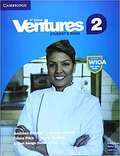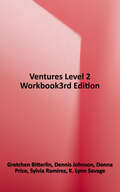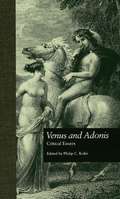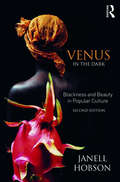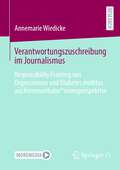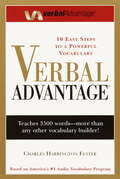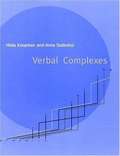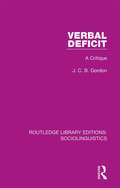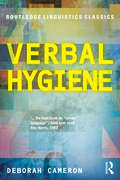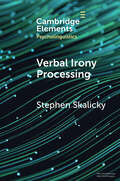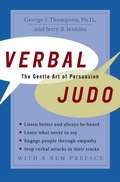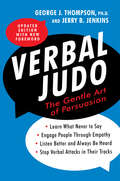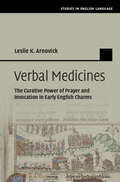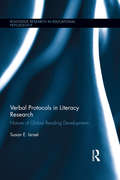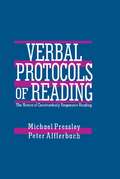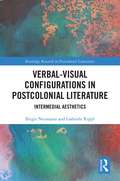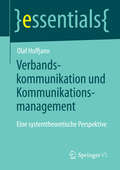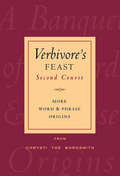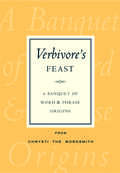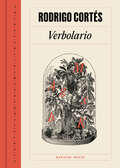- Table View
- List View
Ventures Level 2 Student's Book (Ventures)
by Gretchen BitterlinVentures 3rd Edition Level 2 Student's Book has 10 units with six lessons each, based on relevant adult-learner themes. Two-page lessons are designed for an hour of classroom instruction and are aligned to teach students the skills needed for success in college and careers. Culture notes, speaking, reading, and writing tips enrich and support exercises. Review Units include sections focusing on pronunciation. A College and Careers section in the back of the book addresses needs for more reading practice. Students can access audio and grammar presentation videos using the QR codes found throughout the book.
Ventures Level 4 Student's Book
by Gretchen Bitterlin Dennis Johnson Donna Price Sylvia RamirezVentures 3rd Edition Level 4 Student's Book has 10 units with six lessons each, based on relevant adult learner themes. Two page lessons are designed for an hour of classroom instruction and are aligned to teach students the skills needed for success in college and careers. Culture notes, speaking, reading, and writing tips enrich and support exercises. Review Units include sections focusing on pronunciation. A College and Careers section in the back of the book addresses needs for more reading practice. Students can access audio and grammar presentation videos using the QR codes found throughout the book.
Ventures Level 4 Workbook
by Gretchen Bitterlin Dennis Johnson Donna Price Sylvia RamirezThe Ventures 3rd Edition Level 4 Workbook has exercises to help reinforce lessons in the Student's Book, with an answer key for self-study. Students can access audio to help improve listening, grammar, and reading comprehension using QR codes found throughout the Workbook.
Ventures Workbook Level 2
by Gretchen Bitterlin Dennis Johnson Donna Price Sylvia RamirezThe Ventures 3rd Edition Level 2 Workbook has exercises to help reinforce lessons in the Student's Book, with an answer key for self-study. Students can access audio to help improve listening, grammar, and reading comprehension using QR codes found throughout the Workbook.
Ventures: Basic Workbook (Ventures Series)
by BitterlinGretchenThe Ventures 3rd Edition Basic Workbook has exercises to help reinforce lessons in the Student's Book, with an answer key for self-study. Students can access audio to help improve listening, grammar, and reading comprehension using QR codes found throughout the Workbook.
Venus and Adonis: Critical Essays (Shakespeare Criticism Ser. #No. 16)
by Philip C. KolinThis is the first collection of critical essays devoted exclusively to Shakespeare's first published work, his long narrative poem Venus and Adonis which established his reputation as the literary darling of London and the heir of Ovid. Particularly important is the book's coverage of the little-known presence of Venus and Adonis on stage.A s
Venus in the Dark: Blackness and Beauty in Popular Culture
by Janell HobsonIn this second edition of the remarkable, and now classic, cultural history of black women’s beauty, Venus in the Dark, Janell Hobson explores the enduring figure of the "Hottentot Venus" and the history of critical and artistic responses to her by black women in contemporary photography, film, literature, music, and dance. In 1810, Sara Baartman was taken from South Africa to Europe, where she was put on display at circuses, salons, museums, and universities as the "Hottentot Venus." The subsequent legacy of representations of black women’s sexuality—from Josephine Baker to Serena Williams to hip-hop and dancehall videos—refer back to her iconic image. Via a new preface, Hobson argues for the continuing influence of Baartman’s legacy, as her image still reverberates through the contemporary marketization of black women’s bodies, from popular music and pornography to advertising. A brand new chapter explores how historical echoes from previous eras map onto highly visible bodies in the twenty-first century. It analyzes fetishistic spectacles of the black "booty," with particular emphasis on the role of Beyoncé Knowles in the popularization of the "bootylicious" body, and the counter-aesthetic the singer has gone on to advance for black women’s bodies and beauty politics. By studying the imagery of the "Hottentot Venus," from the nineteenth century to now, readers are invited to confront the racial and sexual objectification and embodied resistance that make up a significant part of black women’s experience.
Venus in the Dark: Blackness and Beauty in Popular Culture
by Janell HobsonIn this second edition of the remarkable, and now classic, cultural history of black women’s beauty, Venus in the Dark, Janell Hobson explores the enduring figure of the "Hottentot Venus" and the history of critical and artistic responses to her by black women in contemporary photography, film, literature, music, and dance.In 1810, Sara Baartman was taken from South Africa to Europe, where she was put on display at circuses, salons, museums, and universities as the "Hottentot Venus." The subsequent legacy of representations of black women’s sexuality—from Josephine Baker to Serena Williams to hip-hop and dancehall videos—refer back to her iconic image. Via a new preface, Hobson argues for the continuing influence of Baartman’s legacy, as her image still reverberates through the contemporary marketization of black women’s bodies, from popular music and pornography to advertising. A brand new chapter explores how historical echoes from previous eras map onto highly visible bodies in the twenty-first century. It analyzes fetishistic spectacles of the black "booty," with particular emphasis on the role of Beyoncé Knowles in the popularization of the "bootylicious" body, and the counter-aesthetic the singer has gone on to advance for black women’s bodies and beauty politics.By studying the imagery of the "Hottentot Venus," from the nineteenth century to now, readers are invited to confront the racial and sexual objectification and embodied resistance that make up a significant part of black women’s experience.
Verantwortungszuschreibung im Journalismus: Responsibility Framing von Depressionen und Diabetes mellitus aus Kommunikator*innenperspektive
by Annemarie WiedickeDie Art und Weise, in der wir als Gesellschaft mit Gesundheit und Krankheit umgehen, wird maßgeblich durch Fragen der (Eigen-)Verantwortung geprägt: Wer ist verantwortlich dafür, dass ein Mensch erkrankt? Die Person selbst, ihr soziales Umfeld, oder strukturelle Gegebenheiten? Und wessen Aufgabe ist es, das entstandene Problem zu beheben? Wie oder wem Menschen gesundheitliche Verantwortung zuschreiben, wird nicht zuletzt durch das Framing in der journalistischen Berichterstattung beeinflusst. Einem interdisziplinären Ansatz folgend beleuchtet dieses Buch die Responsibility Frames in der Berichterstattung und ihren Entstehungsprozess – das Responsibility Frame Building. Am Beispiel von Depressionen und Diabetes mellitus werden mittels einer Kombination von Inhaltsanalyse und Leitfadeninterviews die mediale Darstellung von Verantwortung im Gesundheitskontext, die krankheitsspezifischen Vorstellungen von Journalist*innen sowie die individuellen, organisatorischen und externen Einflüsse auf die Berichterstattung beleuchtet. Die Befunde liefern einen wichtigen Einblick in Frame Building Prozesse in der journalistischen Nachrichtenproduktion. Dabei zeigt sich, dass Journalist*innen eine zentrale Rolle für die mediale Zuschreibung gesundheitlicher Verantwortung zukommt.
Verb Forms at A Glance - Fourth Edition
by V. C. Khatri Nikunj Khatri"Verb Forms at a Glance" by V.C. Khatri is a comprehensive reference guide designed for learners, educators, and language enthusiasts to master English verb forms. This book systematically categorizes and explains regular and irregular verbs, providing clear rules and examples for constructing verb forms across all tenses. It includes an alphabetical listing of verbs with their base forms, past tense, and past participles, making it a quick and reliable reference. Additional sections detail the usage of participles, nuanced rules for forming verb endings, and distinctions between active and passive voice. With its practical examples, pronunciation guides, and focus on commonly used verbs, this book is an indispensable tool for improving grammatical accuracy and fluency in English.
Verbal Advantage
by Charles Harrington ElsterFirst time in book form! A successful program for teaching 3,500 vocabulary words that successful people need to know, based on America's #1 bestselling audio vocabulary series."People judge you by the words you use." Millions of Americans know this phrase from radio and print advertising for the Verbal Advantage audio series, which has sold over 100,000 copies. Now this bestselling information is available for the first time in book form, in an easy-to-follow, graduated vocabulary building program that teaches an outstanding vocabulary in just ten steps. Unlike other vocabulary books, Verbal Advantage provides a complete learning experience, with clear explanations of meanings, word histories, usages, pronunciation, and more. Far more than a cram session for a standardized test, the book is designed as a lifetime vocabulary builder, teaching a vocabulary shared by only the top percentage of Americans, with a proven method that helps the knowledge last.A 10-step vocabulary program teaches 500 key words and 3,000 synonyms. Lively, accessible writing from an expert author and radio personality. From the Trade Paperback edition.
Verbal Complexes
by Hilda J. Koopman Anna SzabolcsiThe central idea of Dynamic Antisymmetry is that movement and phrase structure are not independent properties of grammar; more specifically, that movement is triggered by the geometry of phrase structure. Assuming a minimalist framework, movement is traced back to the necessity for natural language to organize words in linear order at the interface with the perceptual-articulatory module. Andrea Moro uses this innovative perspective to analyze several empirical domains, focusing on small clauses, split wh-movement, and clitic constructions. In a final speculative chapter, he examines the general consequences for the design of grammar implied by Dynamic Antisymmetry. The book is self-contained, with a synopsis of current theories of movement and a synthetic presentation of the theory of antisymmetry. An appendix presents the essentials of a unified theory of copular sentences, which plays a central role in the argument and has several important consequences for syntax, for example, for expletives and locality. Linguistic Inquiry Monograph No. 38.
Verbal Deficit: A Critique (Routledge Library Editions: Sociolinguistics)
by J. C. GordonOriginally published in 1981. Verbal deficit theories try to account for differential educational attainments in linguistic terms, suggesting that children reach varying levels of success in school as a result of their ability or inability to express themselves, and relate this to social class. This critique considers such theories, especially in the form propounded by Bernstein, primarily from a sociolinguistic viewpoint but with special attention to the historical and educational context behind the theories. It claims that verbal deficit theories are not only unscientific and non-linguistic, but are educationally damaging as well, and proposes instead a linguistic ‘difference’ theory.
Verbal Hygiene (Routledge Linguistics Classics)
by Deborah CameronIn Verbal Hygiene, Deborah Cameron takes a serious look at popular attitudes towards language and examines the practices by which people attempt to regulate its use. Instead of dismissing the practice of ‘verbal hygiene’, as a misguided and pernicious exercise, she argues that popular discourse about language values – good and bad, right and wrong – serves an important function for those engaged in it. A series of case studies deal with specific examples of verbal hygiene: the regulation of ‘style’ by editors, the teaching of English grammar in schools, the movements for and against so-called ‘politically correct’ language and the advice given to women on how they can speak more effectively. This Routledge Linguistics Classic includes a new foreword which looks at how the issues covered in the case studies have developed over time and a new afterword which discusses new concerns which have emerged in the last 15 years, from the regimentation of language in the workplace to panics about immigration and terrorism, which are expressed in linguistic terms. Addressed to linguists, to professional language-users of all kinds, and to anyone interested in language and culture, Verbal Hygiene calls for legitimate concerns about language and value to be discussed, by experts and lay-speakers alike, in a rational and critical spirit.
Verbal Irony Processing (Elements in Psycholinguistics)
by Stephen SkalickyIronic language is a salient reminder that speakers of all languages do not always mean what they say. While ironic language has captured the attention of theorists and scholars for centuries, it is only since the 1980s that psycholinguistic methods have been employed to investigate how readers and hearers detect, process, and comprehend ironic language. This Element reviews the foundational definitions, theories, and psycholinguistic models of ironic language, covering key questions such as the distinction between literal and ironic meaning, the role of contextual information during irony processing, and the cognitive mechanisms involved. These key questions continue to motivate new studies and methodological innovations, providing ample opportunity for future researchers who wish to continue exploring how ironic language is processed and understood.
Verbal Judo
by George ThompsonImprove communication, resolve conflicts, and avoid the most common conversational disasters through simple, easily remembered strategies that deflect and redirect negative behaviour. Verbal Judo is the martial art of the mind and mouth that can show you how to be better prepared in every verbal encounter. Listen and speak more effectively, engage people through empathy (the most powerful word in the English language), avoid the most common conversational disasters, and use proven strategies that allow you to successfully communicate your point of view and take the upper hand in most disputes.
Verbal Judo, Second Edition: The Gentle Art of Persuasion (Police Science Ser.)
by George J. Thompson"When you react, the event controls you. When you respond, you're in control."Verbal Judo is the classic guide to the martial art of the mind and mouth that can help you defuse confrontations and generate cooperation, whether you're talking to a boss, a spouse, or even a teenager. For more than a generation, Dr. George J. Thompson's essential handbook has taught people how to communicate more confidently and persuasively in any situation. Verbal Judo shows you how to listen and speak more effectively, engage others through empathy (the most powerful word in the English language), avoid the most common conversational disasters, and use proven strategies to successfully express your point of view--and take the lead in most disputes.This updated edition includes a new foreword and a chapter featuring Dr. Thompson's five universal truths of "human interaction": People feel the need to be respected People would rather be asked than be told People have a desire to know why People prefer to have options over threats People want to have a second chanceStop being frustrated and misunderstood. Stop finding yourself on the losing end of an argument. With Verbal Judo you'll be able to have your say--and say what you mean.
Verbal Medicines: The Curative Power of Prayer and Invocation in Early English Charms (Studies in English Language)
by Leslie K. ArnovickReligious texts played a central role in Early English, and this innovative book looks in particular at how medieval Christians used prayers and psalms in healing the sick. At first glance, the variety and multiplicity of utterances, prayers, exorcistic formulas, and other incantations found in a single charm may seem to be random and eclectic. However, this book shows that charms had distinct, logical linguistic characteristics, as well performative aspects that were shaped by their usage and cultural significance. Together, these qualities gave the texts a unique role in the early development of English, in particular its use in ritual and folklore. Arnovick identifies four forms of incantations and a full chapter is devoted to each form, arranged to reflect the lived experiences of medieval Christians, from their baptism in infancy, to daily prayer and attendance at Church celebrations, and to their Confession and anointing during grave illness.
Verbal Protocols in Literacy Research: Nature of Global Reading Development (Routledge Research in Educational Psychology #3)
by Susan E. IsraelThis volume offers an updated analysis of the methodology of reading and reading research since 1995, when the landmark book Verbal Protocols of Reading: The Nature of Constructively Responsive Reading by Michael Pressley and Peter Afflerbach was published. It offers a thorough cross-analysis of the conscious processes experienced during reading, the structure of reading comprehension, and its application to more current initiatives such as Common Core State Standards and Response to Intervention. It also provides a detailed analysis of Constructively Responsive Reading through relevant online self-report studies in reading and reading comprehension behavior. It is a fresh and comprehensive volume that speaks not only to reading researchers, but to literacy teachers at all levels.
Verbal Protocols of Reading: The Nature of Constructively Responsive Reading
by Peter Afflerbach Michael PressleyResearchers from a variety of disciplines have collected verbal protocols of reading as a window on conscious reading processes. Because such work has occurred in different disciplines, many who have conducted verbal protocol analyses have been unaware of the research of others. This volume brings together the existing literature from the various fields in which verbal protocols of reading have been generated. In so doing, the authors provide an organized catalog of all conscious verbal processes reported in studies to date -- the most complete analysis of conscious reading now available in the literature. When the results of all of the studies are considered, there is clear support for a number of models of reading comprehension including reader response theories, schema perspectives, executive processing models, and bottom-up approaches such as the one proposed by van Dijk and Kintsch. The summary of results also demonstrates that none of the existing models goes far enough. Thus, a new framework -- constructively responsive reading -- is described. This new model encompasses reader response, schematic and executive processing, and induction from word- and phrase-level comprehension to higher-order meaning. The important concept in this new model is that readers respond to bits and pieces of text as they are encountered, all as part of the overarching goal of constructing meaning from text. This volume also includes a critical review of the thinking aloud methodology as it has been used thus far. This examination suggests that it continues to be an immature methodology, and that much work is needed if a complete theory of conscious processing during reading is to be developed via verbal protocol analysis. Finally, after reviewing what has been accomplished to date, the authors provide extensive discussion of the work that remains to be done and the adequacy of the verbal protocol methodology for permitting telling conclusions about text processing.
Verbal-Visual Configurations in Postcolonial Literature: Intermedial Aesthetics (Routledge Research in Postcolonial Literatures)
by Gabriele Rippl Birgit NeumannExamining a range of contemporary Anglophone texts, this book opens up postcolonial and transcultural studies for discussions of visuality and vision. It argues that the preoccupation with visual practices in Anglophone literatures addresses the power of images, vision and visual aesthetics to regulate cultural visibility and modes of identification in an unevenly structured world. The representation of visual practices in the imaginative realm of fiction opens up a zone in which established orders of the sayable and visible may be revised and transformed. In 12 chapters, the book examines narrative fiction by writers such as Michael Ondaatje, Derek Walcott, Salman Rushdie, David Dabydeen and NoViolet Bulawayo, who employ word-image relations to explore the historically fraught links between visual practices and the experience of modernity in a transcultural context. Against this conceptual background, the examination of verbal-visual relations will illustrate how Anglophone fiction models alternative modes of re-presentation that reflect critically on hegemonic visual regimes and reach out for new, more pluralized forms of exchange.
Verbandskommunikation und Kommunikationsmanagement: Eine systemtheoretische Perspektive (essentials)
by Olaf HoffjannIn diesem Band wird auf einer systemtheoretischen Grundlage eine Theorie der Verbandskommunikation entwickelt. In Verbänden stellen sich drei zentrale Probleme: das Problem der Legitimation gegenüber dem politisch-administrativen System, das Problem zurückgehender Mitgliederbindungen sowie die Widersprüche, die sich aus der Bearbeitung dieser Probleme ergeben. Zur Lösung dieser drei Probleme haben sich mit der Legitimationskommunikation, der Mitgliederbindungskommunikation und dem integrierten Kommunikationsmanagement drei Disziplinen ausdifferenziert, die der klassischen Verbandskommunikation zugeordnet werden können. Damit wird eine Spezialisierungs- und Integrationsperspektive gleichermaßen eingenommen: Zunächst wird zu untersuchen sein, wie die Probleme fehlender Unterstützung und der Legitimation bearbeitet werden, um anschließend zu fragen, wie die daraus entstehenden Widersprüche bearbeitet werden.
Verbivore's Feast, Second Course: More Word & Phrase Origins
by Chrysti Meuller SmithIn this companion edition to her popular Verbivore’s Feast, Chrysti the Wordsmith once again examines the evolution and history of the English language, using the odd expressions and clichés that pepper it. Exploring words such as lollygag and quack, and phrases ranging from break a leg to shake a stick and from adam’s apple to trip the light fantastic, Chrysti the Wordsmith uncovers fascinating stories about their origins.
Verbivore's Feast: A Banquet of Word & Phrase Origins
by Chrysti Meuller SmithWhat led to the expression "let the cat out of the bag"? Why do we call blondes "towheads"? For Pete's sake, what is a fangle? In this humorous and engaging collection of word origins and histories, the famed host of the "Chrysti the Wordsmith" series (heard on Yellowstone Public Radio, Montana Public Radio, Montana State University's KGLT-FM, and Armed Forces Radio and Television Service) shares the stories behind the words. This irresistible medley is a must for word lovers everywhere.
Verbolario
by Rodrigo CortésRodrigo Cortés regresa a las librerías con Verbolario: diccionario satírico, humorístico y poético, que, con sus más de dos mil definiciones y siete años de trabajo a la espalda, se atreve a enmendarle la plana al diccionario. «Verbolario es un milagro sostenido».Manuel Jabois Toda palabra tiene su significado oculto —su significado verdadero— acechante entre sus pliegues con la astucia del salteador de caminos; se desvela sólo con el uso y sólo ante la perspicacia y el oído, que son el mismo sentido. Rodrigo Cortés reinventa el lenguaje y hace confesar a cada voz su auténtico propósito. Verbolario no define las palabras: las desnuda. La crítica ha dicho:«Selvático y misterioso antidiccionario en que las palabras vuelven a ser territorios a la espera de ser explorados».Laura Fernández «Verbolario es el saloncillo antes de la obra, los camerinos llenos de secretos del diccionario».José Luis Garci «Cortés desvela una realidad que nadie había visto en el lenguaje: las palabras también juegan con nosotros».Jesús García Calero, ABC Cultural «¿Puede un libro ser a la vez diccionario, manual de humor, tratado filosófico y poemario? En manos de Rodrigo Cortés puede».Juan Gómez-Jurado «Con talento y picardía, Rodrigo Cortés logra ponerle a cada palabra de este Verbolario la espina precisa para que el pinchazo nos resulte puñeteramente gozoso».Fernando Aramburu «Enciclopedia ilustrada que mira el mundo con la sabiduría del viejo y la inocencia del niño».Ana Iris Simón «Carcajadas, sonrisas y la leve incomodidad que produce la verdad cuando anda desnuda».Sergio del Molino
